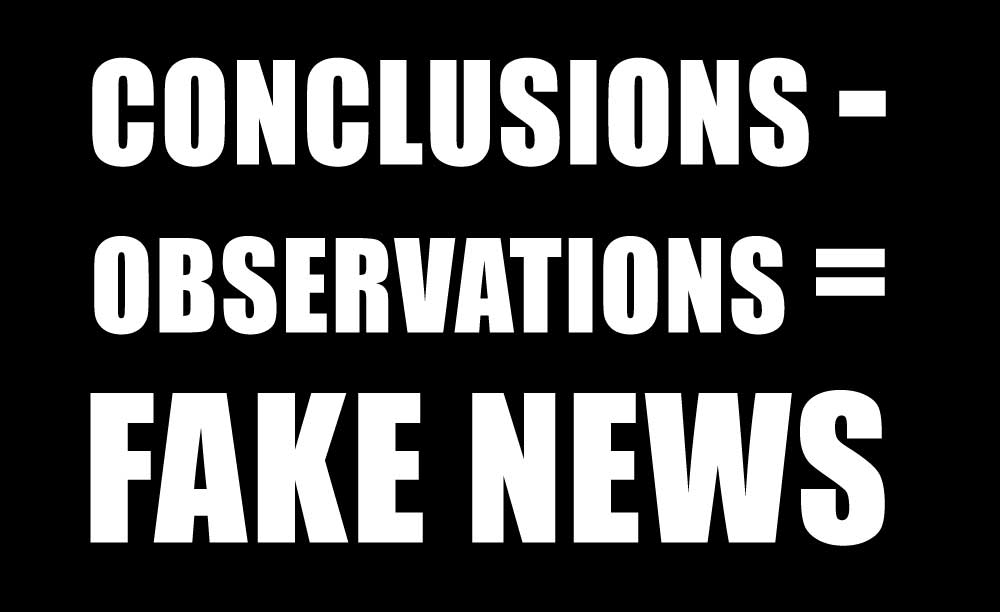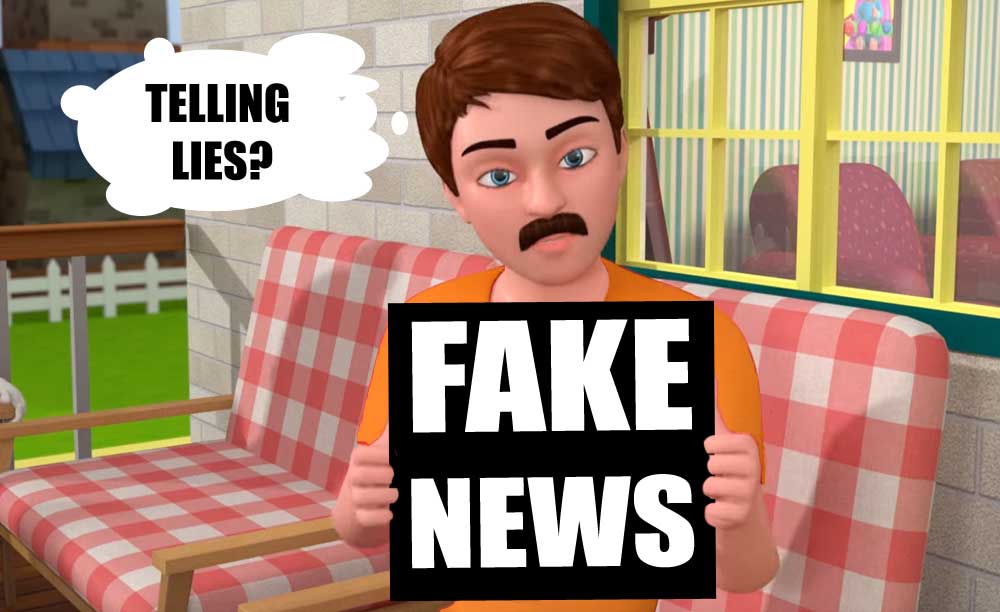You can detect fake news. You can stop fake news. Fake news is a term describing dishonest journalism, something that’s always been around, something we’re aware of now more than ever. Fake news gets spread when there’s an agenda, a reason to affirm narratives with dishonest information. Political agendas have driven so much transparently dishonest reporting that audiences now aren’t as easily fooled as they once were. The credibility of the field of journalism has taken a hit as a result.
Fake news is information that’s untrue, inaccurate, deceptive or just plain lies. The best way to stop fake news is to call it out when you find it. This is how you stop it. YOU can make propagandists who think there’s still room to spread fake news instead regret using it.
Fake news is bad. Whether it’s global, national, state level or local, audiences are valuable to manipulate because they’re voters and consumers. It’s big business because it works. It works because audiences’ ability to tell fake news from real news in in short supply. The civics classes babyboomers took decades ago didn’t account for there being thousands of competing news sources; they couldn’t foresee technology gifting us with the ability to reach audiences so personally. There was no way to see beyond opinions being pushed by national media sources; there were no alternative viewpoints creating transparency and debate so freely.
It’s not hopeless. You don’t have to be fooled – When certain terms are clearly defined it’s easier to navigate the digital sea of information, the Internet and traditional media. Understanding certain basic information handling concepts makes it easier to see who is trying to fool us and who is providing information we can trust. There are some basic definitions, basic concepts that you need to understand. Knowing some distinctions is a defense against dishonesty – you’ll be armed against fake news. The four terms are: observations, conclusions, credibility, and authority.
Observation is when someone uses their senses to experience a phenomenon directly. For example: someone can live through a motorcycle crash and tell you what happened. Someone can witness that same motorcycle crash. They were observers. They all saw it directly. People can arrive afterwards and observe the damage, and become observers of the damage, but that didn’t make them observers of the event, only observers of the aftermath. Observation is limited, but as far as knowing something there’s no other way to get started, no more original or raw way to gain knowledge. Knowledge is dependent on observation.
Conclusions are derived from observations, hopefully. Conclusions are statements that are made about observations, or lack thereof sometimes, which may or may not take observations into account logically. Logical conclusions take into account the observations and describe the events in a way that agrees with them and the premises derived from them. Less than logical conclusions are often reported, however, because the reporter “sticks his finger on the scale” and concludes something that doesn’t represent reality accurately, motivated by narrative more than observations. Faulty logic and inaccurate observations find their way into reporting driven by a pre-conceived narrative. Faulty reporting is fake news.

Let’s consider the example of a motorcycle crash:
A motorcyclist is sharing a small road with a large truck. The biker goes off the road and crashes into a tree, messes up the bike, but walks away generally OK. A witness to the event, standing by the side of the road, watched the entire thing. After the crash the truck driver stops to make sure the biker wasn’t hurt. The biker becomes irate at the truck driver and accuses the trucker of running him off the road.
All three of these people experienced the event, observed it, directly. However, their narratives, what they want to believe, are all different. The motorcyclist wants to believe it was the trucker’s fault. The trucker doesn’t want to believe it’s his fault. The witness has no motivation to believe anything outside of what they just observed. Both the trucker and the biker are quick to support conclusions but only the witness can really be trusted, assuming the witness had no relation to the biker or trucker.
Both the driver and the trucker want to support their own personal narratives, that each is a competent driver, and have something to lose if they are proven to be at fault. Even though both the trucker and the driver experienced the event themselves, first hand, they both have reasons to be biased in their reporting.
Only the witness has nothing at stake when reporting the event to authorities. Even though the witness wasn’t involved in the event themselves they did observe the event first hand. The witness has the role that news consumers expect from news reporters: providing the observations and conclusions absent attachment to narrative.
A reporter who records the testimony of the biker and the trucker would be receiving both observations and conclusions. The recorder, the reporter, might create their own conclusions as they observed the testimony, observations and conclusions taken second hand. Hopefully the reporter wouldn’t use it as an opportunity to enforce their own biases. If they did, their account could be called fake news. When it’s evident that a reporter is offering you only conclusions without offering the key observations they based those conclusions on then you can bet they’re feeding you fake news.
News, and Testimony, Are Really Just Second Hand
When something cannot be observed directly, the information about it needs to be inferred or accepted when it’s second hand. (YSoP#7) We’ve depended on our news sources reliable second hand testimony, trusting them to relate to us a complete and accurate picture of what’s happening. News has it’s implicit limits though: there’s a limit in broadcast time; so we never expect to hear the whole story. There’s a limit to a reader’s attention and time that needs to be respected when writing articles. Reporters arrive after the fact, when a newsworthy event has already transpired. Whether predicting a future event or providing evidence for past events, a reporter and readers are left with having to settle for some implicit uncertainty, settle for just a part of the story. A certain amount of uncertainty is always present – what matters is how credible the testimony is or how long it goes on.
If someone is asserting something that’s likely to be true we recognize that their assertion is more credible than someone who is asserting something unlikely. However, we also have a similar bias for things that are less credible, but fit the narratives we want to believe. Fake news has been demonstrated to propagate faster than credible news. When something fits someone’s biases they are prone to repeat it, share it on the Internet. A recent journal article in Science Magazine revealed: “fake news spreads faster than true news on Twitter—thanks to people, not bots.” This article demonstrated how conclusions were shared without credible evidence, when the message fit the readers’ narratives.
If an opinion or conclusion is accompanied by evidence then it becomes more credible. The more irrefutable evidence there is, the more credibility the conclusions supported by it become. We see this with statistics, when samples are drawn from a population and measured. If the sample is small then the conclusions drawn from it have a high margin of error. If a sample is large then it’s known to be a more representative sample. In a poll, for example, when a small number of people participate the margin of error is high. The results yielded by the poll are less certain compared to when the number of people polled had been larger.
When someone testifies, makes a statement, they can be questioned about their certainty. They can even attest to many observations they made first hand, over a long period of time and under different conditions that make them certain. Alternately they can say that they’re guessing, that they have little evidence, and their guess was provided with little certainty (whether they admit it or not). The quantity and quality of what they’ve got to make conclusions with determines their statement’s certainty and therefore it’s credibility.
Practicing Credibility vs. Abusing Authority
When I was a scientist testing water we were required to prove, with recorded data, that our findings were credible. This meant being scientific, being discrete, being precise, being honest to yourself, and yieldings results that others would be able to duplicate. In order to make some kind of general conclusion “you can’t drink that water” we’d have to say why, not just that it looks bad or is smelly. Our obligation was to be able to report the raw data, the observations we recorded, for example giving the exact concentrations of specific toxins.
If someone pointed to a water source and said to me “that water is undrinkable” they’d be providing me with a conclusion, but not really raw data. Since I’m interested it’s natural for me to want to see the raw data, to see if I agree with that conclusion. If that person then said to me “I don’t have raw data” or “I don’t want to show you” or “It’s not your right to know” I’d be very suspicious of their conclusion.
Suppose I was a public health authority . If I was completely dismissive when asked why I believed the town’s water was safe to drink then it would be fair to say I was abusing my authority. If I said “It’s safe to drink because I am the Public Health Official and I have the power to declare it safe” then I wouldn’t be meeting the responsibility I had as the authority. An authority’s responsibility is to produce credible conclusions. An authority that omits the elements that defend their conclusions is not behaving properly – it’s credible therefore to believe that the authority is defending their own narrative – not the truth.
We often look to authority to interpret raw data for us and give us the conclusions we trust them to yield. Often the details are hard to understand or so numerous that listing them all is outside the scope of an opinion piece. In those cases we want an authority to sum things up, provide us with the interpretation of raw data, provide us with their conclusions. We trust the authority to have done the homework. We expect them to have collected and analysed all the raw data. We trust authorities to base their conclusions on the raw data, not opinions, and to not put their “finger on the scale” to make the data agree with their hypothesis, their pre-conceived narrative. If questioned, we trust authorities can provide us with records they kept, accurate representations of what they’ve found, the raw data they’ve collected. An authority who has done this is happy to review their data, proud of the defensibly of their conclusions.
An authority who does all those things builds their credibility with the people they report to. If they avoid doing those things they erode their authority. An authority who avoids sharing the raw data, doesn’t give references and doesn’t back up their conclusions/opinions is most likely perpetrating fake news.
Fake news is easily detectable once you understand that difference between raw data, credible observations, and conclusions. If someone presents you with conclusions but doesn’t have good raw data, credible observations to share, that’s a good indicator that you’re dealing with fake news.
For example:
You might hear someone say “certain people were not invited to an event” This might be because someone has an agenda to accuse a host of being unwelcoming in general. Since you’re interested you might ask “Who was not invited?”. If the person who is making that accusation refuses to provide you with a name then it’s fair to accuse them of creating “fake news”. The onus was on them to name the specific people who weren’t invited. In that case the raw observation would have been the fact that someone was omitted. If that raw observation couldn’t be produced then it would be fair to accuse the messenger of fake news. Why? Because conclusions came without raw data to support them.
For example:
You might hear a lobbyist ask in a poll “Do you prefer clean, shiny polished metal or dull, rusted, dirty metal?” They’ll sum up all the responses. Then they’ll use that data to conclude “Residents of this community support jobs, industry growth, and companies that care about the environment.” The next thing you know there’s a metal plating company making the property next to yours into an EPA Superfund site, contaminating the groundwater with toxic levels of heavy metals because they’re doing chrome plating. The conclusions about what residents wanted didn’t reference the raw data from the survey, specifically revealing the exact question asked. The conclusions might be qualified with text explaining how “weighting factors” were applied and all sorts of other mathematical hi-jinks to bend numbers around. Lobbyist relationships to the companies they’re lobbying creates narratives with a strong need to produce fake news.
For example:
You might hear someone make a claim about a political candidate, attach some kind of label to them, like “resident friendly” or “cozy with developers”. Those are easy labels to attach to someone if you’re not saying why. How someone voted, how they decided on important issues when they got the chance, either yes or no, are indisputable data points. Votes can be defended but once they’ve been cast they can’t be changed. It’s really hard to say “I voted that way but….” Statements politicians make are fair if they’re framed in a complete enough context, but can be fake news when they’re not.
For example:
You might hear someone say “he was reckless with the spending”. That’s a conclusion. Without telling you the details of the overspending, how can you know whether that statement, that opinion, was justified? What was the man’s spending compared to? Without those two data points, what’s considered normal spending and what’s being pointed to as overspending, making that conclusion without them is fake news. Expecting your audience to just trust you that your conclusion is wrong because your conclusions came without raw data to support them.
You don’t have to settle for thin conclusions and inferences: demand the data. An authority has the responsibility of providing credible information: conclusions backed up by observation. Anything less is Fake News.














